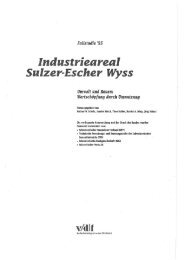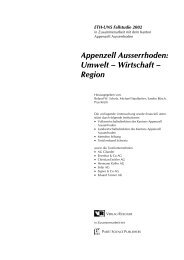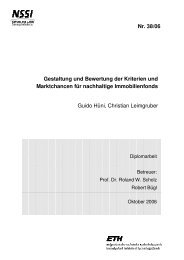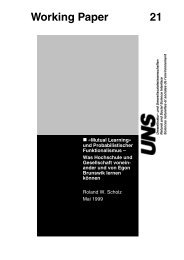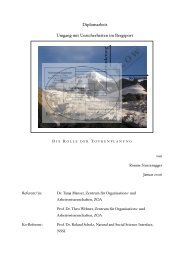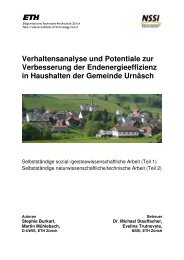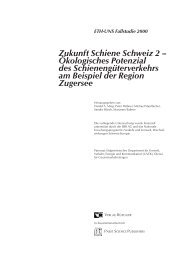The Paradigm of Human-Environment Systems - Natural and Social ...
The Paradigm of Human-Environment Systems - Natural and Social ...
The Paradigm of Human-Environment Systems - Natural and Social ...
Create successful ePaper yourself
Turn your PDF publications into a flip-book with our unique Google optimized e-Paper software.
Rol<strong>and</strong> W. Scholz & Claudia Binder<br />
<strong>The</strong> Rationale <strong>of</strong> the <strong>Human</strong>-<strong>Environment</strong> <strong>Systems</strong> <strong>Paradigm</strong><br />
<strong>Human</strong>-<strong>Environment</strong> <strong>Systems</strong> (HES) are conceptualized as a mutualism between two dif-<br />
ferent systems that exist in essential dependencies <strong>and</strong> reciprocal endorsement. <strong>The</strong> HES-relationship<br />
is not symmetric, yet the mutuality is considered beneficial or necessary for existence<br />
for at least one <strong>of</strong> the two subunits <strong>of</strong> this system. Examples for mutualisms in different disciplines<br />
are: the predator-prey relationship in biology (Volterra, 1931), the mother-child connection<br />
in developmental psychology (Bowlby, 1951, 1982), or the doctor-patient relationship in<br />
medical sciences (Silverman, 1998).<br />
<strong>The</strong> term human systems has been used since the time <strong>of</strong> the ancient Greeks with re-<br />
spect to the meaning <strong>of</strong> social systems, ranging from society to individuals (Apostle, 1952).<br />
<strong>The</strong>se systems are supposed to have a memory, language, foresight, consciousness etc. In contrast<br />
to the concept <strong>of</strong> human or social systems, the term environmental systems is not older<br />
than 200 years. <strong>The</strong> definition <strong>of</strong> environment as the “conditions under which any person or<br />
thing lives or is developed; the sum-total <strong>of</strong> influences which modify <strong>and</strong> determine the development<br />
<strong>of</strong> life or character” (Simpson & Weiner, 1989 p. 315) arose in the 19 th century, when<br />
environmental impacts <strong>of</strong> the industrial age could already be readily observed. Our notion <strong>of</strong><br />
systems refers to J.F. Miller, who defines systems as “a set <strong>of</strong> related definitions, assumptions,<br />
<strong>and</strong> propositions that deal with ” cut-outs <strong>of</strong>“ reality as an integrated hierarchy <strong>of</strong> organizations<br />
<strong>of</strong> matter, energy”, <strong>and</strong>/or organisms (Miller 1978, p. 9).<br />
Because <strong>of</strong> the novelty <strong>of</strong> the term environmental system, research under the name environment<br />
is relatively new. Table 1 differentiates between one sided <strong>and</strong> mutual impact chains<br />
<strong>and</strong> between different viewpoints that dominate research on the human environment relationship.<br />
<strong>The</strong> E → H impact chain has predominantly been studied from the human perspective.<br />
Indeed, Hippocrates had already dealt with environmental impacts on human health in<br />
early medicine in 420 BC. <strong>Environment</strong>al psychology, for example, primarily focuses on “the<br />
influence <strong>of</strong> physical <strong>and</strong> social features on large-scale, everyday environments <strong>of</strong> human behavior<br />
<strong>and</strong> well-being” (Stokols, 2000, p. 220; see also Stokols & Altmann, 1987; Bronfenbrenner,<br />
1979).<br />
<strong>The</strong> H → E impact chain was also initially examined from the human perspective. In the<br />
early 18 th century, forest engineers investigated how legal or economic restrictions affect the<br />
texture <strong>of</strong> forests (von Carlowitz, 1732). Agricultural, forest, <strong>and</strong> resource economics have<br />
evolved from these beginnings such that modern analyses focus on the question <strong>of</strong> how agricultural<br />
<strong>and</strong> forest yields can be most efficiently obtained (Goodwin, 1977; Drummond <strong>and</strong><br />
Goodwin, 2001) From the environmental research perspective, the H → E impact chain has<br />
quite a different focus, namely how human activities affect the environment or environmental<br />
equilibrium <strong>and</strong> how these impacts can be mitigated (Wood, 1995, Freedmann, 1995).<br />
2 April 2003



